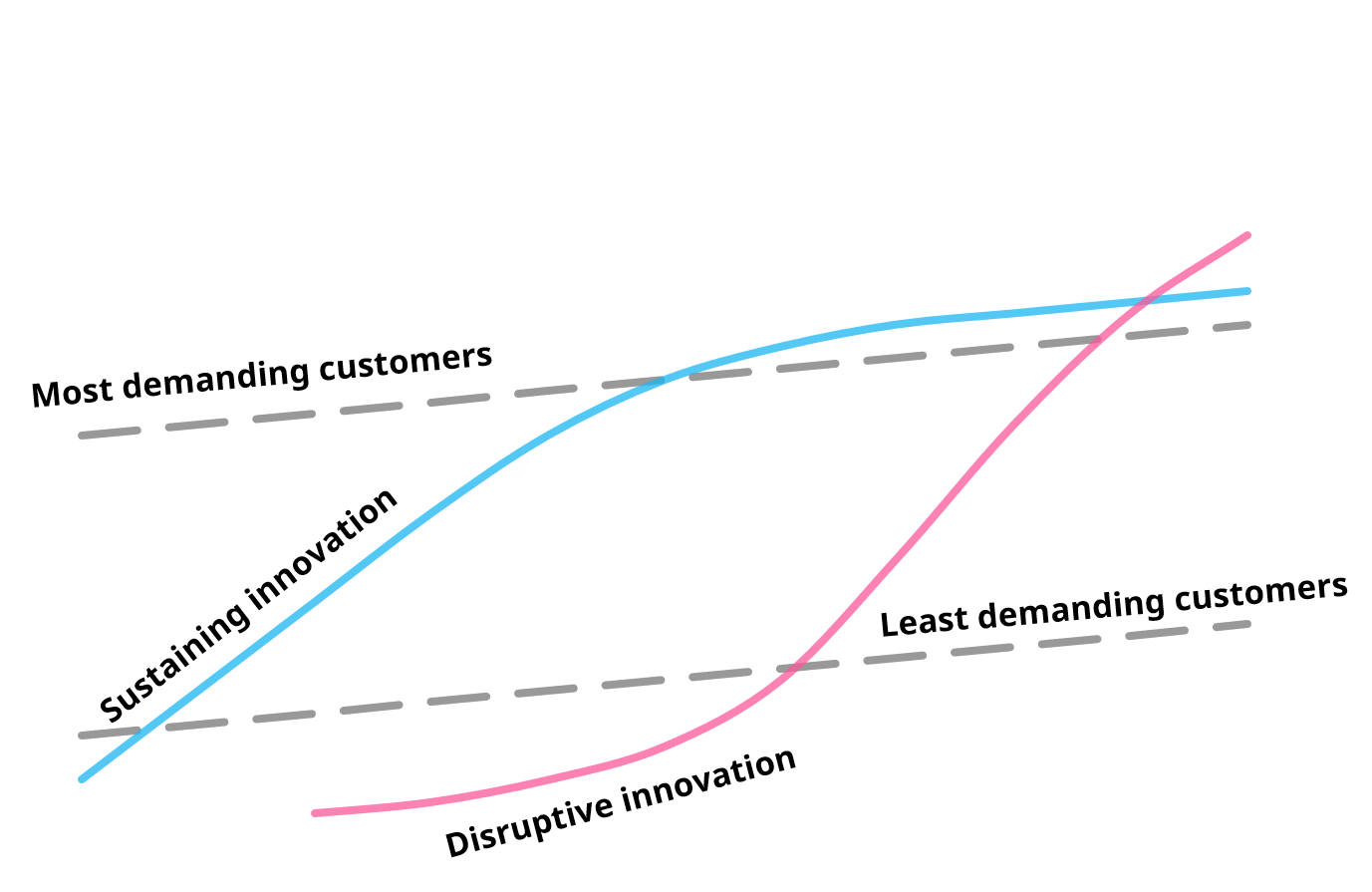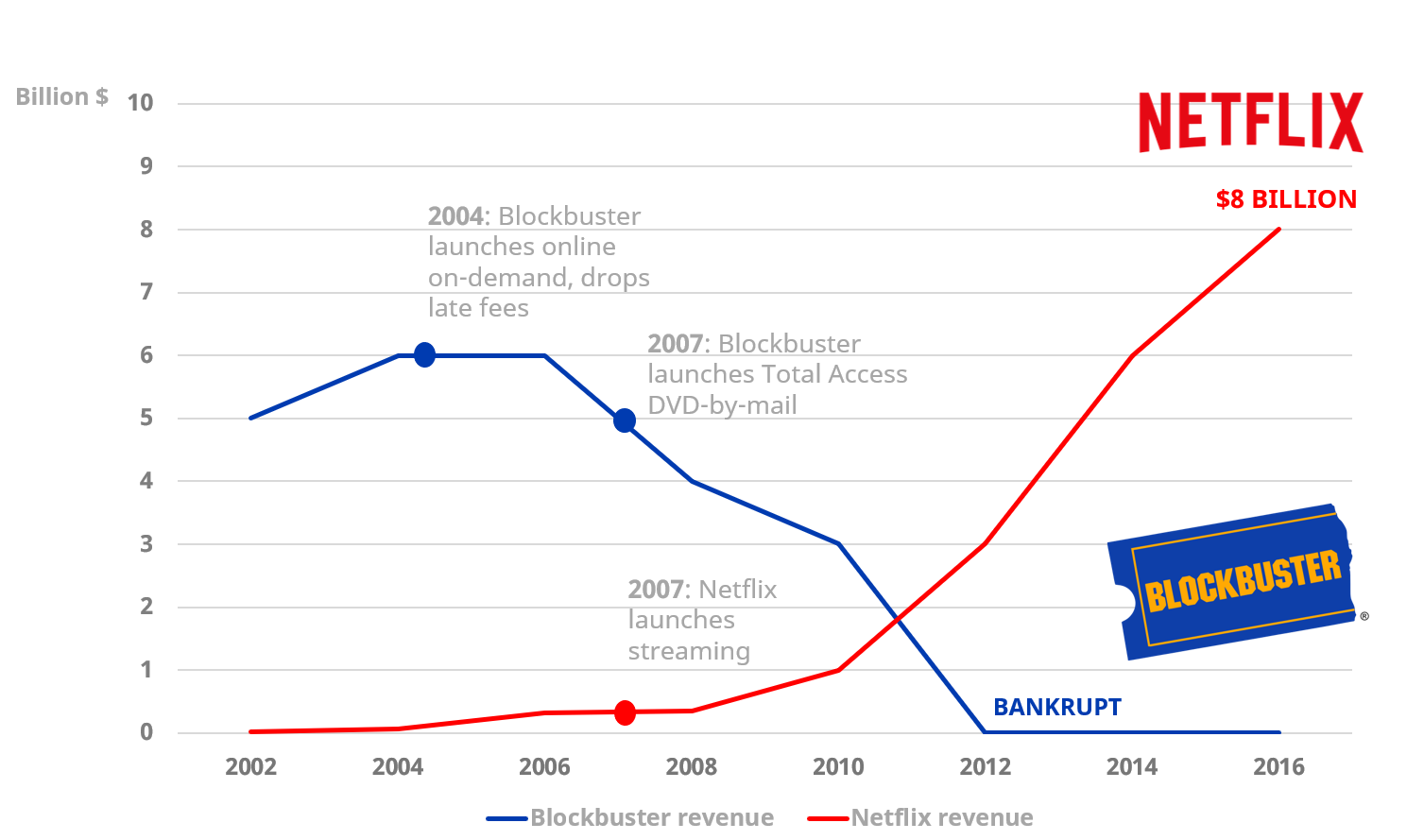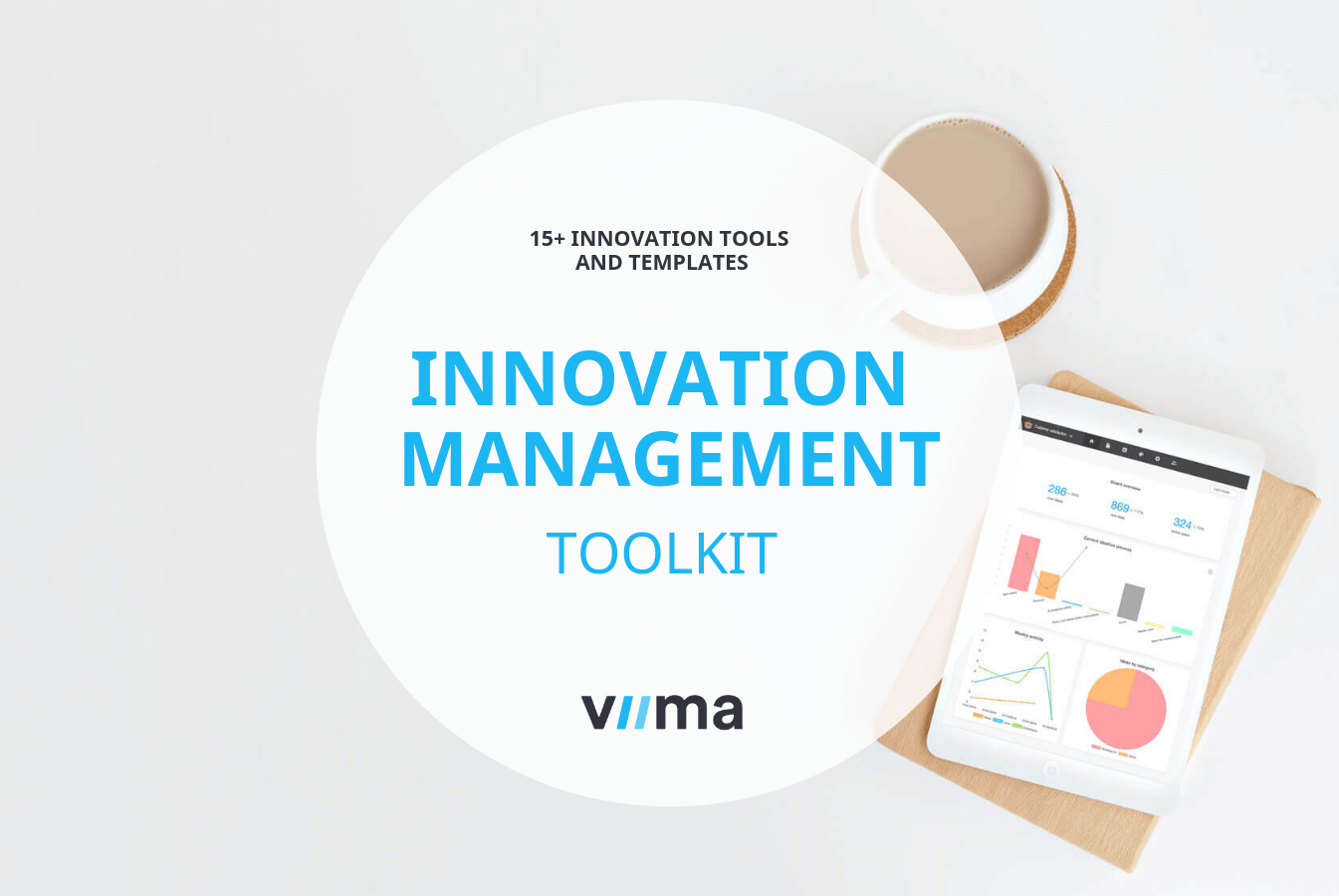Disruptive Innovation – What is It and How Does It Work?
We hear the mainstream media talking about disruption daily. However, only few understand what it actually means or how to create it.
With that in mind, we’ve written this post to help you understand what disruptive innovation is all about and how you can approach it in practice.

We’re currently living in a world of endless choices and opportunities where new products and services are launched at an ever-increasing pace. In the age of innovation, new solutions can be built on top of existing technologies faster than ever before.
This means that there’s a new, even bigger wave of innovation ahead of us and virtually every industry will be affected by this change – one way or another.
Approximately half of the S&P Fortune 500 companies are said to be replaced in the next decade because of disruption. Thus, it’s important for companies not to miss opportunities to adapt.
In this post, we’ll help you take advantage of these changes and prepare for the future. In addition to explaining what disruption means and how you can prepare for it, we’ll also introduce some of the most significant examples of disruptive innovation for you to see how disruption works in the real world.
Table of contents
Disruptive innovation defined
The first step towards creating disruptive innovation is to understand what it’s all about.
Disruptive innovation refers to a concept, product, or a service that either disrupts an existing market or creates a completely new market segment.
In practice, disruption happens when traditional value drivers in an existing market are significantly changed. Typically, a new player enters an existing market with new technology or business model (or a combination of these two), providing new kind of value that differs from the incumbent's offerings.
Disruptive innovation is one of the four types of innovations in the innovation matrix.

Innovator's Dilemma
The concept of disruptive innovation was first defined by Harvard Business School professor Clayton Christensen in a HBR article and introduced in more detail later in his book called Innovator’s Dilemma.
In the beginning, disruptive innovation is inferior to the existing products and services in the market measured by traditional value metrics. When disruptive innovation first enters the market, it initially caters only to a small and typically not very profitable customer segment, while established organizations are focused on serving more demanding, high-end customers.
Because the more demanding customer segment is the one with higher profits, established companies usually choose to focus on serving the more profitable customer segment.
When buying a new phone, for example, rational consumers often buy a brand they’re familiar with. Although the new entrant might use significantly more advanced technology in their product, the mainstream and high-end customer segments rely on the established provider.
The value of disruptive innovation to the mainstream and high-end customer segments is minimal at this point, at the bottom of the S-curve.

Once the disruptive innovation enters the mainstream, the established companies typically pick up on the new concept or technology to respond to the competition. At that point, however, it’s often too late since the new entrant is on the exponential part of the S-curve.
Responding to the new competition solely with new technology often isn’t enough as the market entrant has had a lot of time to refine the offering and business model.
In addition, product development takes time and requires multiple iterations, which makes catching up quite unlikely, even with the additional resources the incumbent has at its disposal.
Characteristics of disruptive innovation:
- Lower margins, at least in the beginning
- Higher risks
- Either disrupts an existing market or creates a new market segment in the existing one
- Sales arguments and measures of value are usually fundamentally changed
- Often involves new technology and/or a new business model
- Happens slowly at first until reaches the mainstream after which grows exponentially
Blind spots
According to Christensen, one of the reasons why building disruptive innovation is challenging for large organizations is because these companies depend on customers and investors for resources. This often means that the best performing companies have well-developed systems for killing ideas their most profitable customers aren’t willing to pay extra for.
Creating disruptive innovation involves bigger risks and incumbents don’t necessarily have a plan for failure. In other words, they aren’t used to considering their initial efforts at commercializing a disruptive technology as learning opportunities.
Instead, they want to maintain their share prices and focus on the most profitable customer segments.

According to Strategic Readiness and Transformation Survey, executives in general may be overconfident in their ability to respond to disruption.
Most leaders were said to underestimate the sources of future competition and instead of considering new market entrants a threat, the biggest competition was seen to come from existing players in the market.
The respondents had also rated changing customer needs, known competitors, and government regulations as the most threatening in terms of their potential to disrupt their core products and services.
Although none of these points are incorrect and definitely shouldn’t be overlooked, the biggest threat of them all is to rely too much on your past success and underestimate the abilities of new market entrants.
As the results of the survey show, Innovator’s Dilemma isn’t just a theory but an actual phenomenon that explains why most established organizations get disrupted in the first place.
Examples of disruptive innovations
One of the best ways to understand disruptive innovation in practice, is to take a look at real-life examples of disruptive technologies and business models that have transformed industries during the past decades.
In the next part of the post, we’ll introduce three case examples that shed some light on how disruptive innovation has transformed certain industries.
Case Salesforce: Software as a Service
The key goals for startups is to create a scalable, repeatable and profitable growth machine. Many businesses today use the SaaS (software as a service) revenue model to achieve that.
Salesforce is considered a pioneer of the SaaS business model – a licensing and delivery model in which software is licensed on a subscription basis.
Salesforce has received the status by delivering its customer relationship management (CRM) software over the internet on a per seat, per month payment plan, instead of deployed on-premise servers under a hefty licensing agreement.

When SaaS business model was first introduced in the beginning of 2000, it wasn’t very successful as it was a lot more complex compared to traditional businesses and the performance couldn’t be measured with traditional value metrics.
For traditional operators, charging a monthly subscription fee would mean a momentarily drop in cash flow, as instead of a five-year license, the customer pays for a month or a year in advance.
When a customer could now cancel the contract at any time, they’d need to start investing a lot of resources in customer satisfaction and customer success, which they traditionally didn’t have to worry about for the first four years.
The companies using SaaS had to invest a lot of resources themselves in building and maintaining scalable infrastructure, making it a business with lower margins.
Compared to traditional operators, the total cost of ownership is typically significantly higher on SaaS. It also involved certain issues related to management and security, as well as data ownership, which the traditional operators and customers weren’t familiar with at the time.
However, from an end user’s perspective, when existing CRM services required high upfront costs and expensive maintenance services, Salesforce could be deployed and configured rapidly and easily. The solution could also be integrated with other applications and platforms.

For Salesforce, its availability, flexibility and ease of maintenance without ongoing work required, were some of the new value drivers for changing the industry as it was able to meet even the most demanding customer expectations.
However, the combination of its new technology and unique business model were the key factors that enabled disruption. Today, basically all modern technology companies use SaaS revenue model to drive scalable growth in their companies.
Case Netflix: On-demand movie streaming service
Netflix is a classic example of disruptive innovation that used a new business model and technology to disrupt an existing market. It initially offered a DVD-by-mail rental service and later launched its online, subscription-based movie streaming service. Today, its on-demand all-you-can-watch movie platform is used by over 150 million people globally.
Throughout the 1990s, things looked different as Blockbuster was expanding rapidly and dominating the video rental industry. The multi-billion-dollar company had over 9 000 video rental stores globally and it employed nearly 85 000 people worldwide.
In 2000s, however, Blockbuster started to lose significant revenue, as Netflix came and targeted segments that had been overlooked by Blockbuster.
What’s interesting about Netflix is that if you want to disrupt an industry, you must be willing to disrupt yourself.
In the beginning, Netflix’s mail-in movie subscription service wasn’t attractive to Blockbuster’s mainstream customers, but rather to those early adopters who were already used to online shopping.
In fact, Netflix did not reach the mainstream until after disrupting itself from its DVD mail service to online streaming. When previously people had to go to the store to rent a movie as well as to return it, they could now access a variety of films and TV shows with fixed monthly subscription fee without having to leave their homes.
When Netflix changed to its subscription-based business model, Blockbuster was still earning billions.

When Netflix eventually started to turn non-customers into customers with its more flexible and accessible online service, Blockbuster responded to the competition by launching its corresponding services.
At this point, however, Netflix was already on the exponential part of the curve and despite Blockbuster’s brand and resources, Netflix had already established its position in the market.
Case AirBnb: Peer to peer lodging service
AirBnb is another example of a major disruptor in the hospitality industry that combines business model innovation and technology.
It provides travellers with an opportunity to live like locals and the platform works as a transaction facilitator between them and the hosts.
The story of AirnBnb started when the founders were forced to think of ways to cover their rent. At that time, they lived in San Francisco and had heard there was a big conference coming to town, due to which, all of the hotel rooms were sold out.
As the guys were looking for a quick way to make a little extra money, they decided to give people the opportunity to stay at their place and sleep on an air mattress. After securing their first bookings and gaining a few positive experiences as hosts, they decided to share the idea with others and target some other upcoming conferences in other cities.
However, the idea wasn't a success from the get-go as they were lacking proper funding and the business idea was so different from what people were used to.
During that time, the economic situation was still on their side as people needed extra income and they kept raising more money to make AirBnb a legitimate business.
In the beginning, AirBnb focused on matching travellers who were looking for a less expensive alternative to living in a hotel with hosts who could provide them with an opportunity to live like locals while making a few extra bucks.
After securing their first premium listing, the business started to gain traction and enjoying positive network effects between the community of hosts and guests, by enticing more users to join and participate.
After getting more and more listings, and eventually reaching the mainstream, it has expanded its offerings by targeting high-value customer segments with AirBnb Plus and Luxe concepts, which are new premium tiers of services on its platform.
Although the company has faced a lot of legal resistance, it has managed to build a business that has 5 million lodging options across 81,000 cities in the world, having more rooms available than any other major hotel chain.

Compared to a traditional hotel industry, AirBnb's competitive advantage is the variety of accommodation options it is able to provide. People can choose between a number of unique listings, such as boats, tents, tree houses, and villas whereas when staying at any of the major hotels, the experience is more or less the same.
The platform creates value both for the demand and supply side as it connects the guests and hosts. In addition, it enables user generated content on the destination locations as well as the individual homes and rooms.
Another factor most hotels can't compete with is the price. Because of AirBnb, people have more opportunities to travel without having to break the bank. In most homes, there's a washing machine for doing your laundry and a kitchen for cooking your own food. Large groups can share one big apartment instead of having to book multiple hotel rooms.
How to prepare for disruption
As the examples show, creating the next disruptive, billion-dollar business idea doesn't happen in the blink of an eye. You need the right capabilities to be able to actually see beyond the industry norms and the right timing to get people to actually care about your idea.
To disrupt a market, you must be willing to cannibalize your existing business, be nimble and embrace taking risks.
Despite the fact that creating disruptive innovation can be a challenge, it doesn’t mean there’s nothing you can do to prepare for it – you just have to approach it differently. In the final part of this post, we’ve listed three simple tips to keep in mind when looking for new disruptive growth opportunities in the current market or the adjacent ones.
1. Listen to your customers and observe the industry trends
"Success breeds complacency. Complacency breeds failure. Only the paranoid survive.”
– Andrew Grove
Being too confident about your abilities to transform and overlooking others’ potential to succeed is a sure way to get blindsided in the ongoing process of innovation.
Thus, keeping an eye on the new entrants in the market and understanding what they’re doing differently compared to the established ones is something worth paying attention to.
Although these new entrants might be targeting a different customer segments at the moment, you don't want to miss potential growth opportunities by only focusing on what's working at the moment for your current customer base.
To keep up with the ongoing change, it's critical to ask the right questions and keep the customer at the core so you're up-to-date on what they actually want and need.
2. Focus on business model innovation
Although technology enables a lot and is often at the core of disruptive innovation, you don’t always have to use revolutionary technology to make a change.
Business model innovation can be used to change how your company delivers value to the customers or captures it from the market.
A concrete tool for business model innovation is The Business Model Canvas – a template by that can be used to describe, design, challenge and pivot your business model. It works in conjunction with other strategic management and execution tools and processes and is best for designing and validating a scalable business model within the market.

With the help of the The Business Model Canvas, you can define, and map nine key strategic areas related to external and internal factors to understand what is required to make your idea a real business.
3. Don't count on breaking through right away
Disruptive innovation should be approached in an iterative manner and with patience. Market disruption doesn’t happen overnight and even the greatest growth opportunities are often discovered through smaller, incremental improvements.
As the aforementioned examples show, none of the businesses were successful from the get-go, but had to go through several phases in order to finally reach the mainstream and to sustain their position in the market.
In the process of uncovering more disruptive opportunities, moving ahead early and getting excited about small gains is the key. You’re likely to face a number of obstacles along your way, which is why it’s important not to get discouraged if (and when) things fail, but to think of your disruptive efforts as learning opportunities.
While patience is important, you should still have a clear picture of what can be achieved and what you want to achieve. One way to make sure you're on the right track is to create a concrete roadmap to guide you to the desired direction.

Over the course of about a decade, Tesla has carried out each step of its Master Plan one by one. It began with producing a low volume, high-end sports car, then using that money to deliver its luxury Model S sedan and Model X luxury SUV before finally introducing its affordable, mass market high-volume car model.
In addition to this, Tesla provides solar power and will continue to follow its Master Plan 2 by creating solar roofs with integrated battery storage, expanding its electric vehicle product line, developing self-driving capabilities and enabling people to make money when they aren't using the car.
To conclude
You don't have to try to be the next Tesla or Salesforce to make good business, especially if you don't have the same resources to invest in global domination as these billion-dollar companies. Thus, it often makes sense to start by disrupting smaller markets locally.
The key to disruptive innovation is the ability to break the existing operating model and create the right conditions for the emergence of a new one.
Disruption is about doing things differently and making a deliberate choice to try to change the general notions in the industry. You need to create new type of value and commit to it even if it's not the most profitable solution in the short term.
However, we've noticed that the best results are achieved by those who simultaneously work on other types of innovations too.
To help you do that, we've created a comprehensive guide that introduces a number of different types of innovations. The purpose of the guide is to help you understand how you can diversify your innovation portfolio and prioritize the areas that need the most improvement.







